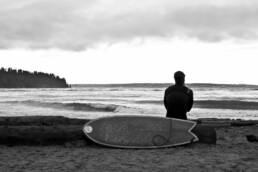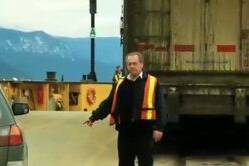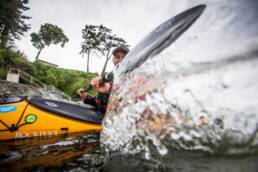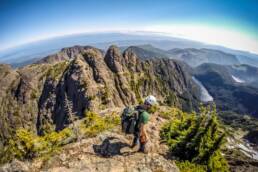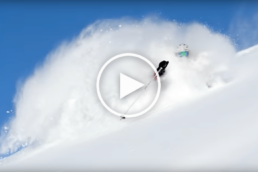It was a trip that didn’t happen. To a peak that you shan’t know. This is the tentative, untapped and newly cooperative world of backcountry access in a place we’re not even sure we’re supposed to be talking about. Words by Andrew Findlay. Photos by Dave Silver.
Somewhere on BC’s Vancouver Island, there’s a helicopter hangar located a few short minutes away from a rugged peak with sweet ski mountaineering terrain. Nearby is a locally famous, DIY, rope tow, built by some industrious citizens decades ago. Let’s call this magical place “Secret Mountain.” No, you can’t get the location. On the southeast coast of Vancouver Island, scurrilous land transactions dating back more than a century have had profound impacts on the way islanders play. Being an outdoor enthusiast here requires adept skills of survival and adaptation, and a willingness to trespass. Like surfers, we don’t share pin drops on maps. Outsiders have been stealing here far too long.

Beginning in 1883, as part of a complex deal to cement BC’s union with Canada, the provincial government gave coal baron Robert Dunsmuir land grants totaling 8,000 square kilometres (3,089 square miles) of Vancouver Island turf; land which had been stolen from the Coast Salish people. In exchange for this windfall, the Scotsman was to develop coal mines and build the Esquimalt and Nanaimo Railway from Victoria to Campbell River. These would help lay the foundation for a prosperous society on the distant Pacific shores of the still young confederation. Dunsmuir became extravagantly rich.
On a Saturday in spring, we marshal gear at 49 North Helicopters for a two-day trip to ski as much as we can. We’re going in heavy: two expedition tents, beer, two-burner stove, bacon. “You guys have quite a beet of gear,” says our cheerful French pilot JB Butard, as he stuffs provisions in the tail boom, ski basket and on the one empty seat.

Being skiers and Euros with a let’s-do-this attitude, Butard, fellow pilot Bastian Fleury and owner Jean-Marc Messner are keen to tap the potential of heli-accessed touring on Vancouver Island. “I think there’s a lot to be done on the Island,” Butard says, surprised that nobody is routinely heli-dropping the low hanging fruit, which is the mountain that shall not be named.
As the chopper powers up, Butard shoulder checks to ensure we’re all seatbelt secured, then hovers above the tarmac before nosing inland toward cloud-shrouded peaks. A mere 10 minutes later, we are unloading the same gear we just packed. The helicopter soon vanishes. We’re alone in silence, on the side of the mountain owned by logging company, Island Timberlands. The other side is owned by its competitor TimberWest. Such is life on the Island. The idea that not one but two companies can have ownership of an entire mountain on Strathcona Provincial Park’s ragged fringe is normal in this land of logging. The relationship between the public and private timberland owners has evolved in recent years from one of conflict to tentative cooperation. In 2016, community mountain bike group, the United Riders of Cumberland (UROC), signed an access agreement with TimberWest for roughly 4,500 hectares (11,120 acres), which legitimizes a rogue trail network, allows Cumberland to leverage its trail assets for tourism and mitigates the logging company’s liability.
The idea that not one but two companies can have ownership of an entire mountain on Strathcona Provincial Park’s ragged fringe is normal in this land of logging.
“People have to realize that mountain biking is not the core business of these companies,” says Mike Manara, a longtime volunteer with the United Riders of Cumberland (UROC.) Neither is skiing.
Monica Bailey, TimberWest’s director of communications, says any recreational access on their property requires permits. “We have provided access agreements to licensed guides for back country skiing,” Bailey says.
Jan Neuspiel, of Island Alpine Guides, is one of them, which is why 49 North wants to team up with him to expand the notion of what’s possible with a chopper on Vancouver Island. Camp erected, we skin along a flat, forested bench and begin switch backing up a broad shoulder toward an alpine ridgeline. The pitch steepens near the crest. Several awkward kick turns later and we’re perched comfortably below the distinctive 1,980-metre (6,496-foot) peak. If you asked an artist to sketch the ideal compact zone for ski touring, it might look like this: abundant couloirs, bowls, steep faces, some spicy adventure, no-fall skiing, and gorgeous natural glades through increasingly rare, ancient, temperate rainforest. In fact, this massif would make a great location for a ski resort. The comparatively diminutive Mount Washington Alpine Resort is visible to the east across the Oyster River divide, the only ski resort on the Isle, notwithstanding the non-profit-society-run Mount Cain near the town of Woss.
I hear Neuspiel’s voice crackling over my hand-held; then, spot him and his group, a quintet of little ants, on an adjacent peak. We inch out onto a shark’s fin sub-ridge, but a patina of rotten snow on bare rock bars access to the face we had scoped from below. We retreat to a gully lower down. The shaded draw has preserved cold powder snow, so the turning is forgiving. We regroup on a broad flat bench below and look back up at the coveted face, split by a pencil couloir. We ascend until skins become futile. Skis on

pack, we kick steps upwards to a narrow opening between rock walls. In half an hour, we have regained our previous highpoint, but on the other side of the rotten snow. A froth of white plops down on the ridge and visibility evaporates. We stomp out comfortable platforms and settle in to wait, but the clouds are lethargic, immoveable. Eventually, we give up on the face and turn attention to the couloir’s rock walls for reference. The feature is steeper and narrower than expected, so I default to an unimpressive sideslip for the upper third, before initiating tentative turns in grabby snow, until the gully fans onto mellower terrain. Our reward—a welcoming, natural, half pipe, flanked by playful steep walls that quickly deliver us back to the campsite.
A symphony of four beer cans opening, then another round. The two-burner is fired up, reheating pre-made sauce and boiling water for spaghetti. The evening is clear. The first stars twinkle in a dark blue sky. To the northeast, a cruise ship, lit like a Christmas ornament, steams northward along Seymour Narrows.
The morning dawns with blue bird promise. We retrace our up-track to the summit ridge, then drop into a long, 35-degree gully to a basin that captures the intense spring sun. From there we ascend an undulating line toward a thumb of snow-rimed basalt that guards the summit like a sentry. We edge around the thumb, then boot pack up pencil-firm, 45-degree snow. In 20 minutes, we’re standing next to the cairn, ripping off skins and anticipating. It’s not the steepness that keeps us alert, but the fatal no-fall zones.
To the north, ugly logging slashes quilt the bench lands unfolding toward the Strait of Georgia, but elsewhere the view is mouthwatering; boundless lines and alpine features that remind why this privately-owned peak is a favorite Island skiing poach. It’s what motivated local DIYers to erect a ski lift on the peak’s lower flanks many years ago.
If you asked an artist to sketch the ideal compact zone for ski touring, it might look like this: Abundant couloirs, bowls, steep faces, some spicy adventure, no-fall skiing and gorgeous natural glades through increasingly rare, ancient temperate rainforest.
Late in the day we find the structure, a tiny A-frame lift shack, next to a sublime mountain tarn, is barely distinguishable from snowcapped boulders. I poke around the scene like a forensic investigator. A Honda four-stroke is attached to a small bull-wheel, upon which “Pay Up $ucker” is written in white paint. Climbing harnesses, webbing and carabiners dangle from nails. Unopened cans of Extra Old Stock perch temptingly next to a toolkit and a red jerrycan of fuel. The cable for the lift is nowhere to be seen and we never find the upper bull wheel. Conclusion? Many beers were consumed and joints smoked during the making of this curious contraption. The YouTube video fills in some of the story gaps; dudes suspended in climbing harnesses from a slow-moving cable that shuttles them upslope, at times 20 metres (66 feet) off the deck. Grassroots skiing at its gritty finest; no permits, no inspections, and not for the weak hearted.
The chopper will be landing in an hour and half, ahead of a forecasted, low pressure system. We leave the makeshift lift shack, slide across the lake and into a forgotten forest, the weathered trunks of ancient yellow cedars festooned in wispy Methuselah’s beard and witch’s hair lichen. By evening, we’ll have flown out, leaving behind little trace other than carbon emissions. Or, maybe this trip didn’t even happen.
Andrew Findlay
Andrew Findlay is an award-winning journalist and photographer with a home base on Vancouver Island. Born and raised in British Columbia, he continues to draw inspiration from the people, places, triumphs and travails of the Canadian West, however he ranges across the globe in pursuit of stories. Andrew’s journalistic interests are many; he enjoys peeling back the complex layers of social, environmental and business issues, but is also inspired by travel and outdoor adventure. Magazine and newspaper assignments have taken him to lands and cultures as diverse as the Great Bear Rainforest of BC, the remote mountains of northwestern Guatemala and the frozen ice hockey ponds of northern India.
Related Stories
History of Ski Aerial Acrobatics
One of the most influential ski films of all time. Dick Barrymores documents what started freestyle skiing. From 1969…
Surfing Vancouver
For Vancouver surfers, finding waves usually means a flight, a ferry or a dash south to Washington. But every so often…
Powder Highway Ski Bum at SWS
Chris Tatsuno has done an amazing job chronicling his Ultimate Ski Bum Powder Highway winnings. In this episode he…
Meet The Youngest Person to Solo Paddle Around Vancouver Island
Seventeen-year-old Finn Steiner has just completed a solo circumnavigation of Vancouver Island via kayak making him the…
Mt. Arrowsmith – Proof There Are Big Mountains on Vancouver Island
Its sightlines span from Mt. Waddington to Mt. Baker. Multiple peaks and righteous rock provide alpinists with a rare…
Fernie Ski Flick Drops This Week
Update: Scroll down to see "Ascent to Powder – Tale of a Ski Town" in its entirety. On Thursday, October 13 the world…



